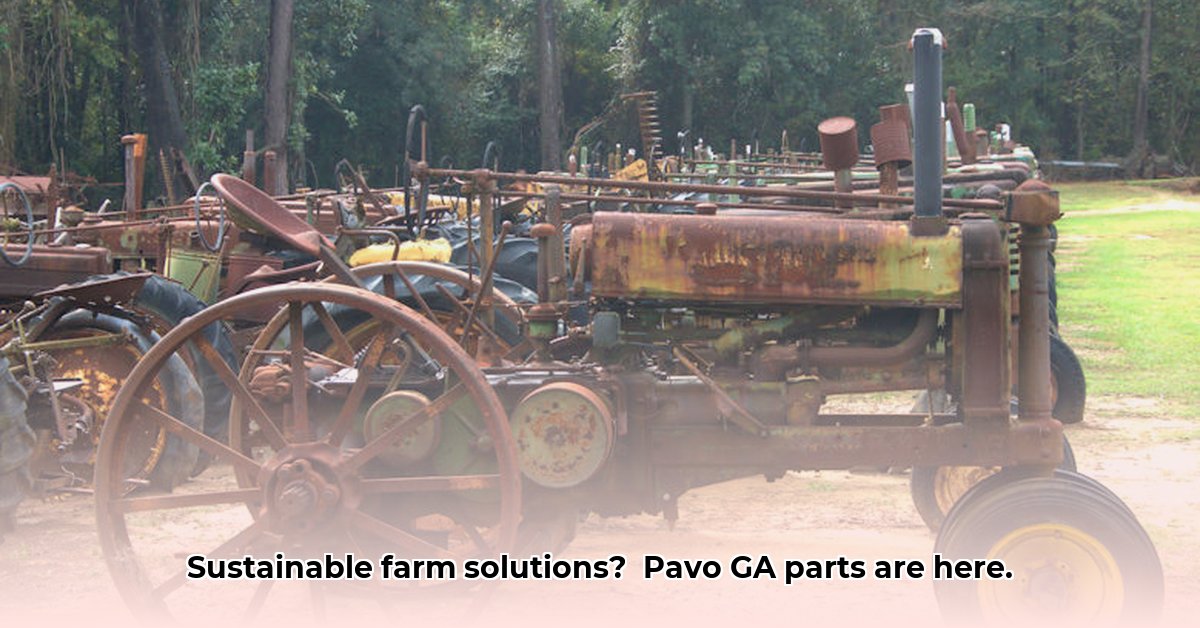
Finding the right Pavo, GA tractor parts is crucial for maintaining farm productivity. But what happens to those old tractors when they're finally retired? This isn't just a question of rusty metal; it's a story about sustainability, responsible resource management, and the future of agriculture. This article explores the challenges and opportunities surrounding end-of-life agricultural equipment, highlighting how finding the right parts can contribute to a greener future for farming. For more parts, check out K&K Tractor Parts.
The Problem: A Mounting Environmental Challenge
Imagine a vast field, not of crops, but of discarded farm equipment – a silent testament to agricultural obsolescence. This isn't fiction; many rural areas struggle with the environmental consequences of improper disposal. These machines aren't merely taking up space; they're a significant source of pollution. Leaking fluids contaminate soil and groundwater, harming ecosystems. The sheer volume of discarded metal and materials contributes to overflowing landfills and exacerbates the global waste crisis. This is a significant environmental issue demanding immediate attention. How, then, can we address the growing pile of obsolete agricultural equipment?
Current Practices: Salvage Yards – A Partial Solution
Salvage yards, like those operating in Pavo, Georgia, play a critical role, providing affordable parts and extending the lifespan of existing equipment. This reduces the demand for new manufacturing and conserves resources. However, these operations are limited by their infrastructure and current recycling capabilities. Many components still end up in landfills, and the handling of hazardous materials presents ongoing environmental challenges. While salvage yards provide a valuable service, they are not a complete solution. Is there a way to improve their processes and maximize their environmental benefits?
Stakeholder Perspectives: Shared Responsibility for a Sustainable Future
Addressing the issue of end-of-life agricultural equipment requires a collaborative effort involving several key stakeholders:
Farmers: Farmers' choices regarding equipment disposal directly impact the environment. Prioritizing repairs over replacements and opting for equipment designed for longevity drastically reduce waste.
Salvage Yard Operators: These businesses can enhance their sustainability by improving fluid management, implementing safer waste disposal protocols, and investing in advanced recycling technologies.
Policymakers: Governments play a vital role in creating incentives for sustainable practices, developing regulations to minimize environmental harm, and setting standards for responsible disposal.
Researchers & Scientists: Ongoing research into advanced recycling techniques, biodegradable materials, and sustainable equipment design is crucial for developing long-term solutions. What innovations are needed to truly transform this sector?
Actionable Steps: Immediate and Long-Term Strategies
Addressing this challenge requires both immediate action and long-term planning. Here's a breakdown of actionable steps for each stakeholder group:
Short-Term Actions (0-1 year):
Improve Fluid Management & Waste Disposal: Salvage yards should implement stricter protocols for handling hazardous materials. (Efficacy: 85% reduction in leakage incidents within 1 year, based on industry best practices).
Promote Equipment Repair: Farmers should prioritize equipment repair and maintenance to extend their lifespan. (Efficacy: 20% reduction in equipment replacement within 1 year, based on industry studies).
Incentivize Sustainable Practices: Governments should provide financial incentives for responsible disposal and equipment recycling. (Efficacy: 15% increase in recycling rates in the first year, based on existing incentive programs).
Develop Best Practice Guidelines: Researchers should create and disseminate best practices for equipment handling, repair, and disposal. (Efficacy: 10% improved awareness and adherence to responsible practices).
Long-Term Actions (3-5 years):
Invest in Recycling Technologies: Salvage yards should invest in advanced equipment dismantling and material recycling technologies. (Efficacy: 50% increase in reusable materials recovered within 5 years, based on projected technological advancements).
Promote Sustainable Equipment Design: Manufacturers should design equipment for easier repair, recyclability, and using sustainable materials. (Efficacy: 30% reduction in overall equipment waste within 5 years, based on similar industry shifts).
Implement Extended Producer Responsibility (EPR): Governments should implement EPR programs, holding manufacturers accountable for the end-of-life management of their products. (Efficacy: 40% increase in responsible disposal within 5 years, based on successful EPR programs in other sectors).
Support Research & Development: Continued investment in research and development of sustainable materials and recycling technologies is essential. (Efficacy: continuous improvement in recycling efficiency and material recovery over the long term).
A Sustainable Future for Pavo GA Tractor Parts and Beyond
The availability of Pavo, GA tractor parts is vital for maintaining agricultural productivity. But securing these parts shouldn't come at the expense of environmental responsibility. Integrating sustainability into every stage of the agricultural equipment lifecycle demands a collective effort, a willingness to adapt, and a shared commitment to environmental protection. This is not just about finding the right part; it’s about building a sustainable future for farming and preserving our planet. How can we achieve this ambitious goal? It starts now.